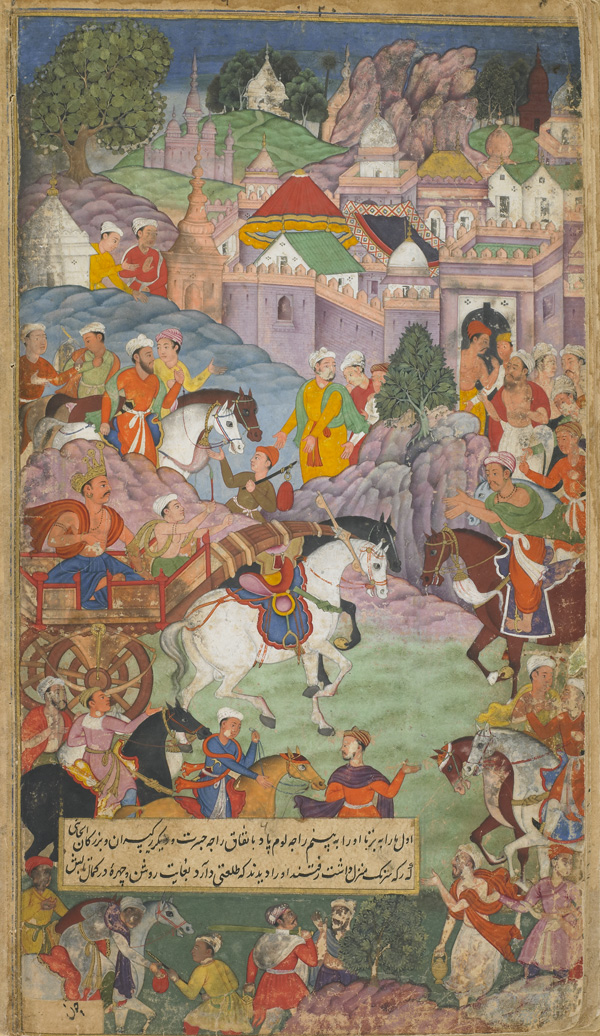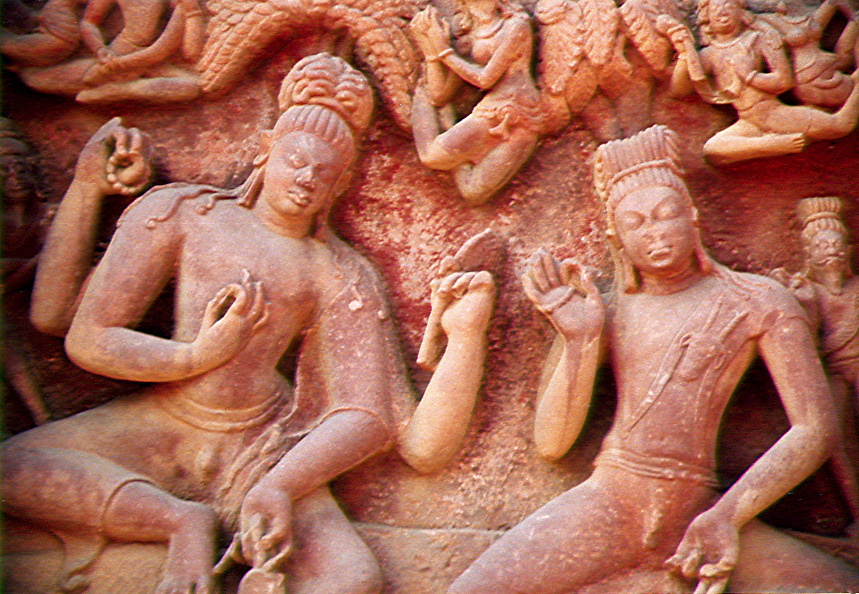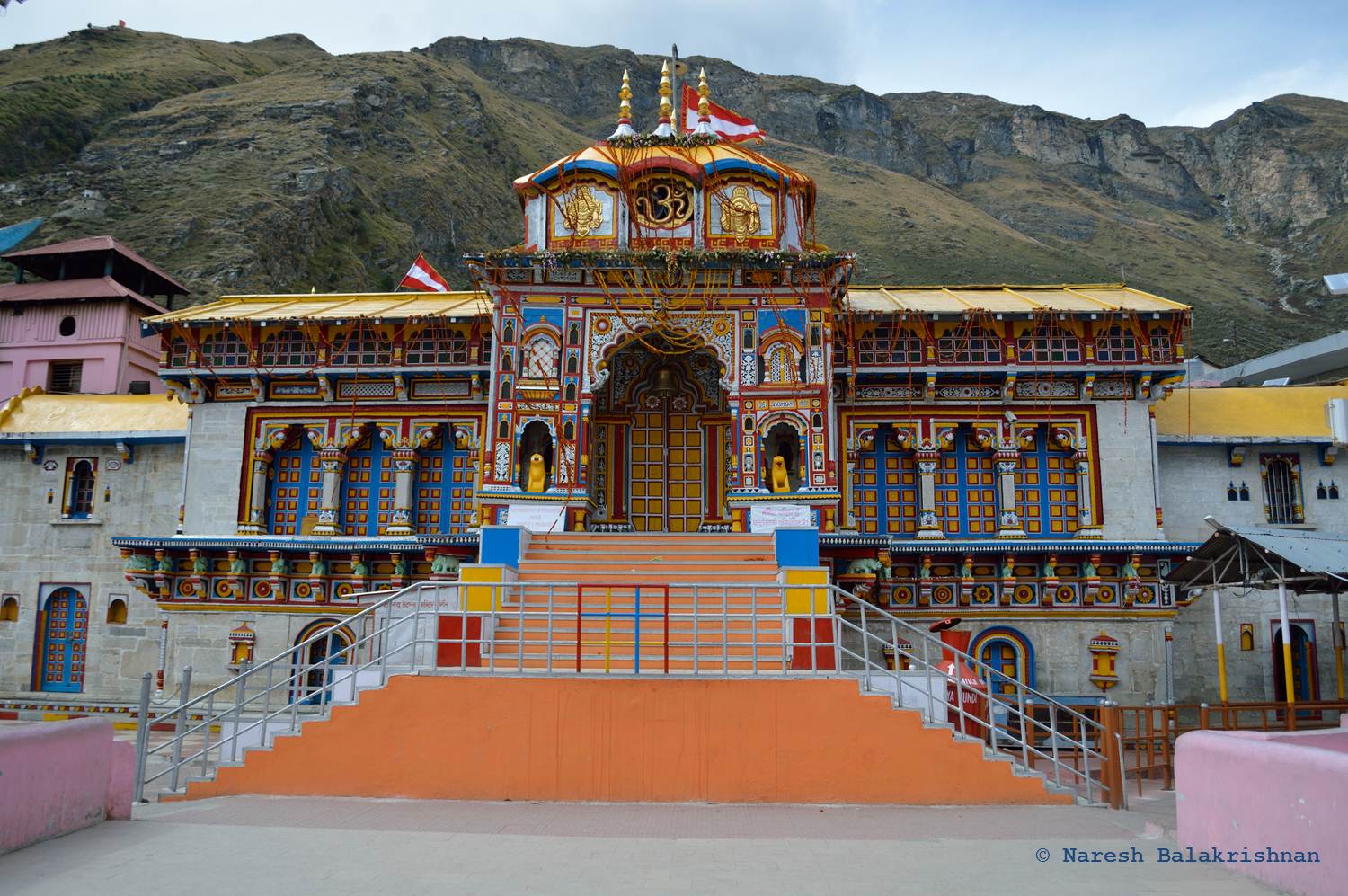|
Vibhandaka
Vibhandaka () is a rishi in Hinduism, belonging to the lineage of Sage Kashyapa. His son was Rishyashringa, featured in the epic Ramayana. Legend The Mahabharata states that Sage Vibhandaka once chanced upon Urvashi, the most beautiful of the apsaras. While observing her, he was so aroused that he produced seminal fluid, which fell into some water. The water was consumed by a female deer, after which the creature subsequently became pregnant, and gave birth to a son whom the sage called Rishyashringa, named for the horns upon his head when he was born. Matha According to the Advaita Vedanta, Adi Sankara established four (Sanskrit: ) (monasteries), with the headquarters at Dvārakā in the West, Jagannatha Puri in the East, Sringeri in the South and Badrikashrama Badrinath is a town and nagar panchayat in Chamoli district in the state of Uttarakhand, India. A Hindu holy place, it is one of the four sites in India's Char Dham pilgrimage and is also part of Ind ... [...More Info...] [...Related Items...] OR: [Wikipedia] [Google] [Baidu] |
Rishyasringa
Rishyasringa ( sa, ऋष्यशृङ्ग; ; Pali: Isisiṅga) is a Rishi mentioned in Indian (Hindu and Buddhist) scriptures from the late first millennium BCE. According to the Hindu epics ''Ramayana'' and ''Mahabharata'', he was a boy born with the horns of a deer who became a seer and was lured by royal courtesans, which led to the yajna (fire sacrifice) of King Dasharatha. His story also occurs in the Buddhist Jatakas, where he is mentioned as the son of Bodhisatta and was tried to be seduced by royal courtesans. Hindu legends The story of Rishyasringa briefly appears in the ''Ramayana'', while a detailed account is narrated in the ''Mahabharata''. Birth According to the ''Mahabharata'', Vibhandaka, a renowned sage and a son of Kashyapa, travels in Mahahrada, when he sees Urvashi, the most beautiful apsara (nymph). Aroused, he emits his seed, which fell into the river. A doe, who is a cursed apsara, swallows it and becomes pregnant due to the sage's miraculous power ... [...More Info...] [...Related Items...] OR: [Wikipedia] [Google] [Baidu] |
Rishyashringa
Rishyasringa ( sa, ऋष्यशृङ्ग; ; Pali: Isisiṅga) is a Rishi mentioned in Indian (Hindu and Buddhist) scriptures from the late first millennium BCE. According to the Hindu epics ''Ramayana'' and ''Mahabharata'', he was a boy born with the horns of a deer who became a seer and was lured by royal courtesans, which led to the yajna (fire sacrifice) of King Dasharatha. His story also occurs in the Buddhist Jatakas, where he is mentioned as the son of Bodhisatta and was tried to be seduced by royal courtesans. Hindu legends The story of Rishyasringa briefly appears in the ''Ramayana'', while a detailed account is narrated in the ''Mahabharata''. Birth According to the ''Mahabharata'', Vibhandaka, a renowned sage and a son of Kashyapa, travels in Mahahrada, when he sees Urvashi, the most beautiful apsara (nymph). Aroused, he emits his seed, which fell into the river. A doe, who is a cursed apsara, swallows it and becomes pregnant due to the sage's miraculous power ... [...More Info...] [...Related Items...] OR: [Wikipedia] [Google] [Baidu] |
Sringeri
Sringeri (IAST: Śṛngēri) also called Shringeri is a hill town and Taluk headquarters located in Chikkamagaluru district in the Indian state of Karnataka. It is the site of the first maṭha ( Dakshinamnaya Sringeri Sharada Peetham) established by Adi Shankara, Hindu theologian and exponent of the Advaita Vedanta philosophy, in the 8th century CE. Located on the banks of the river Tungā, the town draws a large number of pilgrims to its temples of Sri Sharadamba, Sri Vidyashankara, Sri Malahanikareshvara and other deities. Origin of name The name Sringeri is derived from Rishyashringa-giri, a nearby hill that is believed to have contained the hermitage of Rishi Vibhandaka and his son Rishyashringa. In an episode in the Bala-Kanda of the Ramayana, Vasishtha narrates how Rishyashringa brought rains to the drought-stricken kingdom of Romapada. According to legend, Sri Adi Shankara is said to have selected the site as the place to stay and teach his disciples, because whe ... [...More Info...] [...Related Items...] OR: [Wikipedia] [Google] [Baidu] |
Urvashi
Urvashi ( sa, उर्वशी, Urvaśī}) is the most prominent apsara (celestial nymph) in Hindu mythology, considered to be the most beautiful of all the apsaras, and an expert dancer. She is mentioned in both ''Vedic'' and ''Puranic'' scriptures and is often portrayed as a ' swan maiden'. Urvashi is described to be born out of the thigh of sage Narayana and occupies a special place in the court of Indra, the king of the gods and ruler of svarga (heaven). She is famous for her marriage to Pururavas, a mortal king, whom she later abandons. Urvashi is also regarded as the mother of Vedic sages Vashishtha and Agastya. Etymology The Sanskrit name ''"Urvaśī"'' can have multiple meanings. It is derived from roots''uru'' and ''aś''. Some believe that the name has a non- Aryan origin. According to the scripture ''Devi Bhagavata Purana'', the apsara is known as Urvashi because she is born from the ''uru''—'thigh'—of the divine-sage Narayana. Indologist Monier Monier-Wi ... [...More Info...] [...Related Items...] OR: [Wikipedia] [Google] [Baidu] |
Rishi
''Rishi'' () is a term for an accomplished and enlightened person. They find mentions in various Vedic texts. Rishis are believed to have composed hymns of the Vedas. The Post-Vedic tradition of Hinduism regards the rishis as "great yogis" or "sages" who after intense meditation (tapas) realized the supreme truth and eternal knowledge, which they composed into hymns.Hartmut Scharfe (2002), Handbook of Oriental Studies, BRILL Academic, , pp. 13–15. The term appears in Pali literature as Ishi and in Buddhism, they can be either Buddhas, Paccekabuddhas, Arahats or a monk of high rank. Etymology According to Indian tradition, the word may be derived from two different meanings of the root 'rsh' (). Sanskrit grammarians derive this word from the second meaning: "to go, to move". V. S. Apte gives this particular meaning and derivation, and Monier-Williams also gives the same, with some qualification. Another form of this root means "to flow, to move near by flowing". (All the ... [...More Info...] [...Related Items...] OR: [Wikipedia] [Google] [Baidu] |
Adi Sankara
Adi Shankara ("first Shankara," to distinguish him from other Shankaras)(8th cent. CE), also called Adi Shankaracharya ( sa, आदि शङ्कर, आदि शङ्कराचार्य, Ādi Śaṅkarācāryaḥ, lit=First Shankaracharya, ), was an Indian people, Indian Vedanga, Vedic scholar and teacher (''acharya''), whose works present a harmonizing reading of the ''sastras'', with liberating knowledge of the self at its core, synthesizing the Advaita Vedanta teachings of his time. The title of Shankaracharya, Shankracharya, used by heads of the amnaya monasteries is derived from his name. Due to his later fame, over 300 texts are attributed to his name, including commentaries (''Bhāṣya''), introductory topical expositions (''Prakaraṇa grantha'') and poetry (''Stotra''). However most of these are likely to be by admirers or pretenders or scholars with an eponymous name.W Halbfass (1983), Studies in Kumarila and Sankara, Studien zur Indologie und Iranistik, ... [...More Info...] [...Related Items...] OR: [Wikipedia] [Google] [Baidu] |
Badrikashrama
Badrinath is a town and nagar panchayat in Chamoli district in the state of Uttarakhand, India. A Hindu holy place, it is one of the four sites in India's Char Dham pilgrimage and is also part of India's Chota Char Dham pilgrimage circuit. It gets its name from the Badrinath Temple. Etymology ''Badri'' refers to "Badrayana", another name for Rishi Ved Vyas who is believed to have resided in this region. It is also known as "Badarikashrama". History Badrinath was re-established as a major pilgrimage site by Adi Shankara in the 8th century. In earlier days, pilgrims used to walk hundreds of miles to visit the Badrinath temple. The temple has been repeatedly destroyed by earthquakes and avalanches. As late as the First World War, the town consisted only of the 20-odd huts used by the temple's staff, but the site drew thousands each year and up to 50,000 on its duodecennial festivals (every twelve years). In recent years its popularity has increased still more, with an estima ... [...More Info...] [...Related Items...] OR: [Wikipedia] [Google] [Baidu] |
Jagannatha Puri
The Jagannath Temple is an important Hindu temple dedicated to Jagannath, a form of Vishnu - one of the Trimurti, trinity of supreme divinity in Hinduism. Puri is in the state of Odisha, on the eastern coast of India. The present temple was rebuilt from the tenth century onwards, on the site of pre existing temples in the compound but not the main Jagannatha temple, and begun by Anantavarman Chodaganga, the first king of the Eastern Ganga dynasty. The Puri temple is famous for its annual Ratha Yatra, or chariot festival, in which the three principal murti, deities are pulled on huge and elaborately decorated temple cars. Unlike the stone and metal icons found in most Hindu temples, the image of Jagannath (which gave its name to the English term 'juggernaut') is made of wood and is ceremoniously replaced every twelve or 19 years by an exact replica. It is one of the Char Dham pilgrimage sites. The temple is sacred to all Hindus, and especially in those of the Vaishnavism, Vai ... [...More Info...] [...Related Items...] OR: [Wikipedia] [Google] [Baidu] |
Dvārakā
Dvārakā, also known as ''Dvāravatī'' (Sanskrit द्वारका "the gated ity, possibly meaning having many gates, or alternatively having one or several very grand gates), is a sacred historic city in the sacred literature of Hinduism, Jainism,See Jerome H. Bauer "Hero of Wonders, Hero in Deeds"Vasudeva Krishna in Jaina Cosmohistory in and Buddhism. It is also alternatively spelled as Dvarika. The name Dvaraka is said to have been given to the place by Krishna, a major deity in Hinduism. Dvaraka is one of the Sapta Puri (seven sacred cities) of Hinduism. In the ''Mahabharata'', it was a city located in what is now Dwarka, formerly called Kushasthali, the fort of which had to be repaired by the Yadavas. In this epic, the city is described as a capital of the Anarta Kingdom. According to the ''Harivamsa'' the city was located in the region of the Sindhu Kingdom. In the Hindu epics and the Puranas, Dvaraka is called Dvaravati and is one of seven Tirtha (pilgrima ... [...More Info...] [...Related Items...] OR: [Wikipedia] [Google] [Baidu] |
Matha
A ''matha'' (; sa, मठ, ), also written as ''math'', ''muth'', ''mutth'', ''mutt'', or ''mut'', is a Sanskrit word that means 'institute or college', and it also refers to a monastery in Hinduism.Matha Encyclopædia Britannica Online 2009 An alternative term for such a monastery is ''adheenam''. The earliest epigraphical evidence for ''mathas'' related to Hindu-temples comes from the 7th to 10th century CE. The most famous ''mathas'' or ''peethams'', which came to be affiliated with the Advaita tradition in the 14th century, are Govardhanmaṭha Pīṭhaṃ at |
Apsara
An apsaras or apsara ( sa, अप्सरा ' lso ' pi, अक्चरा, translit=accharā) is a type of female spirit of the clouds and waters in Hinduism and Buddhist culture. They figure prominently in the sculpture, dance, literature and painting of many Indian and Southeast Asian cultures. There are two types of apsaras: ''laukika'' (worldly) and ''daivika'' (divine). Urvasi, Menaka, Rambha, Tilottama and Ghritachi are the most famous among them. They are most often depicted in the court and discretion of Indra. Apsaras are widely known as ''Apsara'' ( ) in Khmer, and also called as ''Accharā'' in Pāli, or ''Bidadari'' (Malay, Maranao), ''Biraddali'' ( Tausug, Sinama), ''Hapsari/Apsari'' or ''Widadari/Widyadari'' ( Javanese), ''Helloi'' ( Meitei) and ''Apsorn'' ( th , อัปสร). English translations of the word "Apsara" include "nymph", "fairy", "celestial nymph", and "celestial maiden". In Hinduism, apsaras are beautiful, supernatural female beings. ... [...More Info...] [...Related Items...] OR: [Wikipedia] [Google] [Baidu] |
Advaita Vedanta
''Advaita Vedanta'' (; sa, अद्वैत वेदान्त, ) is a Hinduism, Hindu sādhanā, a path of spiritual discipline and experience, and the oldest extant tradition of the Āstika and nāstika, orthodox Hindu school Vedanta, Vedānta. The term ''Advaita'' (literally "non-secondness", but usually rendered as "nondualism", and often equated with monism) refers to the idea that ''Brahman'' alone is ultimately Satya, real, while the transient phenomenon (philosophy), phenomenal world is an illusory appearance (''Maya (religion), maya'') of Brahman. In this view, (''jiv)Ātman (Hinduism), Ātman'', the experiencing self, and ''Ātman-Brahman'', the highest Self and ultimate Reality, Absolute Reality, is non-different. The ''jivatman'' or individual self is a mere reflection or limitation of singular ''Ātman'' in a multitude of apparent individual bodies. In the Advaita tradition, ''moksha'' (liberation from suffering and rebirth) is attained through recogni ... [...More Info...] [...Related Items...] OR: [Wikipedia] [Google] [Baidu] |











